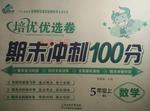题目内容
17.Babies as young as 5months can distinguish a happy tune,such as Ode to Joy,from Beethoven's Ninth Symphony,from sad tunes.Researchers showed an emotionally-neutral face to the babies while sad music played.When the babies looked away from the face,the music stopped and a new sad song started.When the happier Ode to Joy played,the babies stared at the face three to four seconds longer,suggesting they were interested in the change.
By nine months old,babies can do the opposite.
The finding is another example of how babies make sense of the world long before they can talk,said Brigham,Yong University psychology professor Ross Flom.
"One of the first things babies understand communicatively is emotion,so for them the melody(旋律)is the message,"Flom said."Our study showed that by nine months,babies are classifying songs as happy or sad the same way that adults do."
So what makes a happy song?
BYU music professor Susan Kenney,who was not involved in the study,noted some of the technical differences between the happy and sad songs the babies heard.
"The happy songs were all in major keys with fairly short phrases or motives that repeated,"Kinney said."The tempo(节拍)and melodic rhythms were faster than any of the sad ones,and the melodies had a general upward direction.The sad songs were in minor keys and all had a slower beat and long melodic rhythms.For a baby to notice those differences is interesting and attractive."
68.The researchers did the experiment in order toD.
A.help babies learn more knowledge about music
B.find out the most popular music with babies
C.know whether babies are familiar with the face
D.find out if babies would know happy songs from sad ones
69.The phrase"the opposite"in Paragraph 3refers to"B".
A.telling the difference between Ode to Joy and other songs
B.picking out a sad tune from happy ones
C.looking away from the face three to four seconds longer
D.showing they're not interested in the change of tunes
70.This musical study shows thatD.
A.all babies are gifted in music
B.music represents what babies want to tell us
C.babies understand music emotionally even before they can talk
D.the behavior of babies should be further studied
71.How do babies distinguish different tunes according to Kenney?A
A.By the tempo and rhythms.
B.By their emotion.
C.By their common sense.
D.By their interest.
分析 本文为一篇科教文,介绍了一个实验--婴儿能否辨别愉快的音乐和悲伤的音乐.
解答 68---71 DBDA
68.答案D.主旨大意题.根据第一段"Babies as young as 5months can distinguish a happy tune,such as Ode to Joy,from Beethoven's Ninth Symphony,from sad tunes"可知,这篇科普文章主要是介绍婴儿是否能辨别愉快的音乐和忧伤的音乐.
69.答案B.猜测词义题.根据第一句"Babies as young as 5months can distinguish a happy tune,such as Ode to Joy,from Beethoven's Ninth Symphony,from sad tunes"的提示,五个月大的宝宝能识别愉快的音乐,而九个月大的宝宝与此相反,能识别忧伤的音乐.故选B.
70.答案D.判断推理题.根据最后一段"For a baby to notice those differences is interesting and attractive"可知,小宝宝能注意到这些不同仍值得人们研究,故选D.
71.答案A.事实细节题.根据文中"The tempo and melodic rhythms were faster than any of the sad ones"可知,不同之处在于tempo and rhythms,故选A.
点评 答题技巧:1.加强整体意识,把握文章的主要内容.在阅读的时候可给段落标上序号,并给重要的句子和关键词做上记号,尤其是各段中心句,为答题提供更快捷更多的信息源.2.审清题干,发觉和把握试题中有效的提示性信息,确认命题的角度、阅读范围和答题方式.3.定位阅读,强化对应意识.同时要注意原文利用和自我加工相结合.

 金牌教辅培优优选卷期末冲刺100分系列答案
金牌教辅培优优选卷期末冲刺100分系列答案---You _______ have my computer unless you take good care of it.( )
| A. | needn't | B. | mustn't | C. | shouldn't | D. | shan't |
In our junior year,we found that we didn't (39)D a single class.This was not a problem,though.We just talked a little more in the hallway (40)C passing periods.That year seemed to fly by.One day,Ryan asked me to hold the torch (火炬) runner's flag that would (41)A the spot where Ryan would (42)B his Olympic torch run.He gently explained that he would be honored (43)C I would accept this position for him.The Olympic committee sent a letter saying that the person that holds the flag for him must be someone (44)D to him.He said I was the only true friend he had (45)A made that talked to HIM and not to his wheel chair.How could I (46)B such a request?
On the morning of June 5th,as I walked down the sidewalk,my heart (47)B and my mind became a factory of questions.I kept wondering how everything was going to happen and how Ryan would (48)C the huge crowd of thousands of people.
After the van arrived,the other runners got out and lined up outside the van,chanting his name,"Ryan!Ryan!"Then all of the people (49)D in,"Ryan!Ryan!"The lift then lowered Ryan to the ground.There he was,in all his (50)C.
It all became slow motion at the sight of the arriving torch.The runner lit Ryan's torch and then Ryan began his (51)B.As he took off down the street,the chanting became louder and louder.The (52)D filled the air and even I felt like I was on cloud number nine.I could not have been any prouder of Ryan!He (53)A this moment in time--a historic moment--a moment that he was a part of and (54)C me to be a part of,too.
Mr.Weinheimer,the next torch runner,bent over and gave Ryan a hug.That moment will last in time forever.It symbolized the whole (55)D of the flame:love,excitement,enthusiasm,brotherhood,and life of any man.The flame united us all and showed that love is really what makes this small world go around after all.
| 36.A.solutions | B.keys | C.routes | D.responses |
| 37.A.danger | B.fear | C.pain | D.puzzle |
| 38.A.hid | B.prevented | C.released | D.relieved |
| 39.A.change | B.miss | C.attend | D.share |
| 40.A.except | B.for | C.during | D.before |
| 41.A.mark | B.test | C.number | D.decorate |
| 42.A.cover | B.begin | C.continue | D.lead |
| 43.A.while | B.although | C.if | D.unless |
| 44.A.polite | B.kind | C.grateful | D.important |
| 45.A.ever | B.never | C.also | D.even |
| 46.A.admit | B.refuse | C.make | D.repeat |
| 47.A.ached | B.raced | C.stopped | D.sank |
| 48.A.explain to | B.differ from | C.respond to | D.call on |
| 49.A.joined | B.stepped | C.poured | D.broke |
| 50.A.potential | B.preference | C.glory | D.surprise |
| 51.A.training | B.journey | C.life | D.struggle |
| 52.A.anxiety | B.satisfaction | C.harmony | D.excitement |
| 53.A.deserved | B.recalled | C.treasured | D.chose |
| 54.A.promised | B.encouraged | C.allowed | D.followed |
| 55.A.mystery | B.power | C.information | D.meaning |